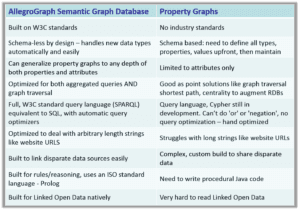Why property graphs fall short
| For simple graph oriented data relationships, a non-semantic (or property graph) database approach might solve a single dimensional problem like: shortest path, one-to-many relationships, weighted elements, structured inter-relationships.
But rarely are problems and queries that simple. Real world data is highly complex, multi-dimensional and needs the powerful additional features of a semantic graph solution. Also, property graphs require the fixed definition of classes/objects, types and nodes – basically a fixed schema. If the data or data sources ever change, those changes need to be coded before any new data can be accessed. |
 |
Can your graph software handle…?
|
|
Comparison of Property Graphs and Semantic Graphs


